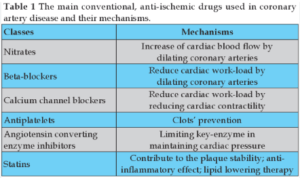Treatment
Treatment of coronary artery disease involves risk factor management, antiplatelet therapy, and antianginal medications. Cessation of Tobacco, exercise and weight loss are the most necessary lifestyle modifications.
Your healthcare provider will discuss the best treatment plan for you. Following your treatment plan is vital to lower your risk of severe complications from CAD.
Medications:
Aspirin is the mainstay of antiplatelet therapy, although clopidogrel is an alternative. Antianginal medications should be added stepwise, starting with a beta-blocker. Calcium channel blockers, nitrates, and ranolazine are adjunctive or second-line therapy when beta-blockers are ineffective or contraindicated. (1)
Figure: Drug classes to treat CAD
Surgical procedure:
Coronary artery surgery in contemporary practice is confined chiefly to coronary artery bypass grafting (CABG), although some groups are reexploring coronary endarterectomy (CE). (2)
- Coronary artery bypass grafting (CABG): This surgery creates a new pathway for blood flow around the blockages. This “diversion” reestablishes blood flow to your heart. Coronary Artery Bypass Grafting helps people with severe blockages in several coronary arteries.
- Percutaneous coronary intervention (PCI): Coronary angioplasty is another name for this procedure. It is minimally invasive. The technician uses a small balloon catheter to reopen your blocked artery and inserts a stent to help your artery stay open, which allows blood to flow through it better.
References:
- Braun, M. M., Stevens, W. A., & Barstow, C. H. (2018). Stable Coronary Artery Disease: Treatment. American family physician, 97(6), 376–384.
- Tully A, Bishop MA. Coronary Artery Surgery. [Updated 2022 Oct 8]. In: StatPearls [Internet]. Treasure Island (FL): StatPearls Publishing; 2022 Jan-. Available from: https://www.ncbi.nlm.nih.gov/books/NBK562187/
Image


